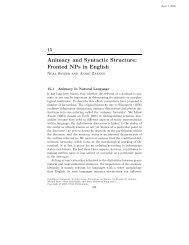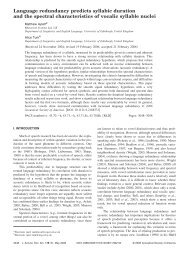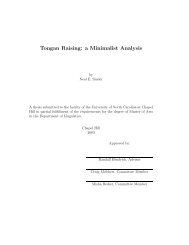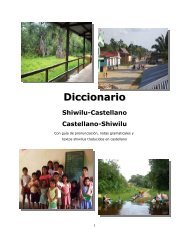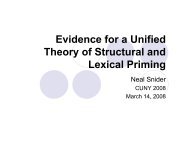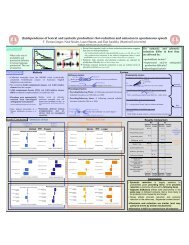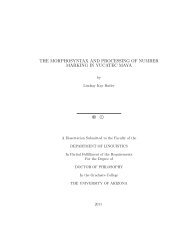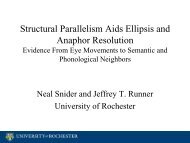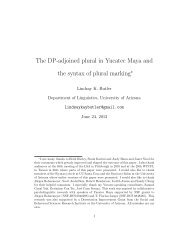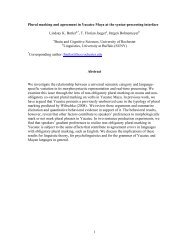Weak definite noun phrases: rich, but not strong, special, but not ...
Weak definite noun phrases: rich, but not strong, special, but not ...
Weak definite noun phrases: rich, but not strong, special, but not ...
Create successful ePaper yourself
Turn your PDF publications into a flip-book with our unique Google optimized e-Paper software.
<<strong>strong</strong>>Weak</<strong>strong</strong>> <<strong>strong</strong>>definite</<strong>strong</strong>> <<strong>strong</strong>>noun</<strong>strong</strong>> <<strong>strong</strong>>phrases</<strong>strong</strong>>: <<strong>strong</strong>>rich</<strong>strong</strong>>, <<strong>strong</strong>>but</<strong>strong</strong>> <<strong>strong</strong>>not</<strong>strong</strong>> <strong>strong</strong>, <strong>special</strong>, <<strong>strong</strong>>but</<strong>strong</strong>> <<strong>strong</strong>>not</<strong>strong</strong>>unique ∗Natalie M. Klein † , Whitney M. Gegg-Harrison † , Rachel S. Sussman ⋄ ,Greg N. Carlson ‡ , Michael K. Tanenhaus ††University of Rochester, Department of Brain and Cognitive Sciences⋄ University of Wisconsin, Madison, Department of Psychology‡University of Rochester, Department of Linguisticscorrespondence to nklein@bcs.rochester.edu1 IntroductionThe <<strong>strong</strong>>definite</<strong>strong</strong>> article paradigmatically appears in <<strong>strong</strong>>noun</<strong>strong</strong>> <<strong>strong</strong>>phrases</<strong>strong</strong>> (NPs) that select a uniquely identifiablereferent from the known world or discourse. The President of the United States of America (atpresent) refers exclusively to George W. Bush; the Peter W. Stanley Professor of Linguistics andPhilosophy at Pomona College is Jay Atlas; the largest planet in our solar system indicates Jupiter.Instances in which the referent of an expression is semantically unique in fact require the <<strong>strong</strong>>definite</<strong>strong</strong>>article. For example, the use of an in<<strong>strong</strong>>definite</<strong>strong</strong>> article with a superlative (such as a largest planet inour solar system) is infelicitous. By contrast, in<<strong>strong</strong>>definite</<strong>strong</strong>> articles canonically introduce new referentsinto the discourse. A bald man with glasses introduces an individual meeting that description intothe common ground as a discourse entity. Unlike a typical <<strong>strong</strong>>definite</<strong>strong</strong>> NP, an in<<strong>strong</strong>>definite</<strong>strong</strong>> NP does <<strong>strong</strong>>not</<strong>strong</strong>>presuppose the unique identifiability of its referent. While the distinction we are drawing here between<<strong>strong</strong>>definite</<strong>strong</strong>> and in<<strong>strong</strong>>definite</<strong>strong</strong>> NPs ignores important nuances, it nevertheless captures the way NPsare generally divided: <<strong>strong</strong>>definite</<strong>strong</strong>> NPs refer to specific, unique discourse entities, and in<<strong>strong</strong>>definite</<strong>strong</strong>> NPsintroduce new discourse entities, or refer to entities that are <<strong>strong</strong>>not</<strong>strong</strong>> necessarily uniquely indentifiable.In this paper we focus on certain <<strong>strong</strong>>definite</<strong>strong</strong>> NPs that do <<strong>strong</strong>>not</<strong>strong</strong>> seem to behave like paradigmatic<<strong>strong</strong>>definite</<strong>strong</strong>> NPs. Carlson and Sussman (2005), inter alios, (e.g. Birner and Ward (1994); Barker (2005))have <<strong>strong</strong>>not</<strong>strong</strong>>ed that some <<strong>strong</strong>>definite</<strong>strong</strong>> NPs appear quite in<<strong>strong</strong>>definite</<strong>strong</strong>> in nature, in that they (1) do <<strong>strong</strong>>not</<strong>strong</strong>> seemto presuppose unique identifiability and (2) do <<strong>strong</strong>>not</<strong>strong</strong>> appear to introduce individual entities into thediscourse. These NPs, which we call weak <<strong>strong</strong>>definite</<strong>strong</strong>>s following Poesio (1994), are the subject of theresearch we will present.Consider the following sentence from Carlson and Sussman (2005):(1) Mary heard about the riot on the radio, and Bill did too.Intuition suggests that Mary and Bill must have heard about the same riot, <<strong>strong</strong>>but</<strong>strong</strong>> <<strong>strong</strong>>not</<strong>strong</strong>> necessarilyby means of the same radio (or even the same radio station). The radio is a weak <<strong>strong</strong>>definite</<strong>strong</strong>> in thissentence: certainly, Mary and Bill could have heard the news on the same radio, <<strong>strong</strong>>but</<strong>strong</strong>> this is <<strong>strong</strong>>not</<strong>strong</strong>>∗ This research was partially supported by NIH grant HD27206.1
necessary, contrary to the predictions of a canonical view of the presuppositions associated with theuse of the <<strong>strong</strong>>definite</<strong>strong</strong>> article. That is, weak <<strong>strong</strong>>definite</<strong>strong</strong>>s are systematically ambiguous between a “regular”reading in which there is a presupposition of a uniquely identifiable referent, and a “weak” reading,where there is <<strong>strong</strong>>not</<strong>strong</strong>>.In the remainder of this paper we first discuss some of the characteristics of weak <<strong>strong</strong>>definite</<strong>strong</strong>> NPs,and then we present two experiments in support of the hypothesis that weak <<strong>strong</strong>>definite</<strong>strong</strong>>s neither carrythe same uniqueness presupposition as regular <<strong>strong</strong>>definite</<strong>strong</strong>> NPs, nor behave as in<<strong>strong</strong>>definite</<strong>strong</strong>>s do. 12 Characteristics of <<strong>strong</strong>>Weak</<strong>strong</strong>> DefinitesTo a first approximation, weak <<strong>strong</strong>>definite</<strong>strong</strong>> readings are restricted to specific <<strong>strong</strong>>noun</<strong>strong</strong>>s in the lexicon 2 . Forexample, although radio allows a weak interpretation of a <<strong>strong</strong>>definite</<strong>strong</strong>> NP in (1), this is <<strong>strong</strong>>not</<strong>strong</strong>> necessarilytrue of synonyms or lexical associates. The following pairs of VP-ellipsis sentences illustrate thelexically restrictive nature of weak <<strong>strong</strong>>definite</<strong>strong</strong>>s:(2) a. Benedict listened to the radio, and Tracy did too.b. Benedict listened to the record, and Tracy did too. 3(3) a. Jacob went to the bank today, and Carmen did too.b. Jacob went to the school today, and Carmen did too.The first sentence in each pair allows a weak interpretation, <<strong>strong</strong>>but</<strong>strong</strong>> the second does <<strong>strong</strong>>not</<strong>strong</strong>>.In addition to lexical constraints, there are also environmental, or compositional, characteristicsof weak <<strong>strong</strong>>definite</<strong>strong</strong>>s. The following examples demonstrate governing and modification restrictions:(4) Benedict kicked the radio, and Tracy did too.(5) Jacob went to the new bank today, and Carmen did too.Changing the identity of the immediate governing verb (as in (4)) or adding modification to the <<strong>strong</strong>>noun</<strong>strong</strong>>phrase containing the weak <<strong>strong</strong>>definite</<strong>strong</strong>> (as in (5)) excludes the weak interpretation. In these examplesonly the <strong>strong</strong> interpretation remains: the same radio and the same bank are unambiguously underdiscussion in the elided VPs.In cases where the weak interpretation is available, the weak <<strong>strong</strong>>definite</<strong>strong</strong>> appears to share manyqualities with in<<strong>strong</strong>>definite</<strong>strong</strong>> NPs. This is clear in the following dialogue:(6) Nats: Where did they take the hurricane victims?Mike: To the arena/ an arena/ the hospital.Nats: Which one?Mike: I don’t know.1 While our experimental materials are in English, weak <<strong>strong</strong>>definite</<strong>strong</strong>>s exist in various language types, as in the followingexamples: Dutch: Hij zit in de gevangenis. (He is in the jail.) Irish: Bíonn a deartháir ar an teilifís. (Her brother ison the television.) Thanks to Anne Pier Salverda and Nicholas Williams for these examples.2 Thanks to Gregory Ward for illuminating cases where <strong>special</strong> contexts potentially coerce weak interpretationswith unexpected <<strong>strong</strong>>noun</<strong>strong</strong>>s, as with turkeys at Thanksgiving.3 There is a type/token distinction to be made here: while it seems entirely plausible for Tracy to have listenedto a different copy of the same record, it is <<strong>strong</strong>>not</<strong>strong</strong>> consistent with the sentence for Tracy to have listened to a differenttype of record.2
Mike’s answer, I don’t know, is infelicitous as a response to Nats’s question Which one? whenthe antecedent of one is a regular <<strong>strong</strong>>definite</<strong>strong</strong>> NP like the arena. In contrast, when the antecedentis an in<<strong>strong</strong>>definite</<strong>strong</strong>> NP, an arena, or a weak <<strong>strong</strong>>definite</<strong>strong</strong>> NP, the hospital, the particular location need<<strong>strong</strong>>not</<strong>strong</strong>> be uniquely identifiable. Despite a superficial <<strong>strong</strong>>definite</<strong>strong</strong>>ness, Mike felicitously utters that thevictims were were taken to the hospital, even when he does <<strong>strong</strong>>not</<strong>strong</strong>> know which one; this uncertainty isinfelicitous with a regular <<strong>strong</strong>>definite</<strong>strong</strong>> like the arena. In situations like these, weak <<strong>strong</strong>>definite</<strong>strong</strong>>s behave muchas in<<strong>strong</strong>>definite</<strong>strong</strong>>s do, and these truth-conditional similarities to in<<strong>strong</strong>>definite</<strong>strong</strong>>s, as well as the acceptabilityof VP anaphora with a non-unique referent, raise the possibility that weak <<strong>strong</strong>>definite</<strong>strong</strong>>s are merelyin<<strong>strong</strong>>definite</<strong>strong</strong>>s in disguise.However, weak <<strong>strong</strong>>definite</<strong>strong</strong>>s appear to convey meanings en<<strong>strong</strong>>rich</<strong>strong</strong>>ed beyond that of in<<strong>strong</strong>>definite</<strong>strong</strong>>s, as wesee when comparing the preferred readings (7a) and (7b):(7) a. Galya is in the hospital. −→ Galya is a patient getting medical treatment.b. Galya is in a hospital. −→ Galya is inside a hospital building in some unknown capacity.The most colloquial weak <<strong>strong</strong>>definite</<strong>strong</strong>>s show en<<strong>strong</strong>>rich</<strong>strong</strong>>ment so salient that it becomes difficult to cancelthe en<<strong>strong</strong>>rich</<strong>strong</strong>>ed interpretation, as demonstrated in the contrast between (8a) and (8b). In (8a),which is completely felicitous, the second clause is consistent with the en<<strong>strong</strong>>rich</<strong>strong</strong>>ed interpretation. Incontrast,(8b), where the second clause <strong>strong</strong>ly favors a regular <<strong>strong</strong>>definite</<strong>strong</strong>> reading, is distinctly odd:(8) a. The plumber got sent to the slammer, because he didn’t pay his taxes.b. #The plumber got sent to the slammer, because a pipe burst in cell block 4.Examples (8a) and (8b) suggest that rather than establishing a discourse entity the way in<<strong>strong</strong>>definite</<strong>strong</strong>>stypically do, weak <<strong>strong</strong>>definite</<strong>strong</strong>>s evoke a conventional activity or event type. This leaves us facedwith conflicting intuitions about the relationship between weak <<strong>strong</strong>>definite</<strong>strong</strong>>s and in<<strong>strong</strong>>definite</<strong>strong</strong>>s. They appearto be truth-conditionally identical; however, the semantic en<<strong>strong</strong>>rich</<strong>strong</strong>>ment or preference for an eventreading rather than an individual reading of weak <<strong>strong</strong>>definite</<strong>strong</strong>>s leads us to believe they are distinct.3 ExperimentsThe goal of the present experiments is to investigate two hypotheses about weak <<strong>strong</strong>>definite</<strong>strong</strong>>s thatare arise from the intuitions presented earlier. In Experiment 1, we investigate the claim thatweak <<strong>strong</strong>>definite</<strong>strong</strong>>s do <<strong>strong</strong>>not</<strong>strong</strong>> presuppose uniqueness. In Experiment 2, we aim to determine the functionalboundaries between in<<strong>strong</strong>>definite</<strong>strong</strong>> <<strong>strong</strong>>noun</<strong>strong</strong>> <<strong>strong</strong>>phrases</<strong>strong</strong>> and weak <<strong>strong</strong>>definite</<strong>strong</strong>> <<strong>strong</strong>>noun</<strong>strong</strong>> <<strong>strong</strong>>phrases</<strong>strong</strong>>. Here, we test thehypothesis that while weak <<strong>strong</strong>>definite</<strong>strong</strong>>s and in<<strong>strong</strong>>definite</<strong>strong</strong>>s are similar because they do <<strong>strong</strong>>not</<strong>strong</strong>> refer to aunique discourse referent (thus felicitously allowing for a certain amount of uncertainty within thediscourse, as illustrated in the example dialogue), they differ: weak <<strong>strong</strong>>definite</<strong>strong</strong>>s fail to establish a newdiscourse referent at all, whereas in<<strong>strong</strong>>definite</<strong>strong</strong>>s do serve to establish a new discourse referent (albeitan in<<strong>strong</strong>>definite</<strong>strong</strong>>, non-unique one). We assume a theory of discourse referents as presented in DiscourseRepresentation Theory (e.g. Kamp and Reyle (1993)).3.1 Experiment 1<<strong>strong</strong>>Weak</<strong>strong</strong>> <<strong>strong</strong>>definite</<strong>strong</strong>> NPs are identical in form to their regular <<strong>strong</strong>>definite</<strong>strong</strong>> counterparts, and because weak<<strong>strong</strong>>definite</<strong>strong</strong>> NPs are systematically ambiguous, the <strong>strong</strong>er coreferential interpretation is always felicitous.Moreover, the co-reference of a typical <<strong>strong</strong>>definite</<strong>strong</strong>> interpretation is visually trivial in a task3
Figure 1: Experiment 1 Setupinvolving the manipulation of objects 4 . Our study took the cognitive ease and truth-conditional”safety” of the <strong>strong</strong>er interpretation into account in its design. Previous work by Brown-Schmidtand Tanenhaus (2008) has established that visual context encourages participants to treat differentlydemarcated regions as independent and cohesive discourse domains. Following this, in thecurrent experiment we aimed to minimize the non-linguistic bias against the weak interpretationby painting each half of a magnetic board a distinct color to evoke two visual domains. Each domaincontained a person, a distracter object, and a non-identical token of the critical <<strong>strong</strong>>noun</<strong>strong</strong>>.Figure 1 shows a cartoon version of the setup. Pre-recorded scenarios were constructed so thateach scenario could be used with a weak <<strong>strong</strong>>definite</<strong>strong</strong>> <<strong>strong</strong>>noun</<strong>strong</strong>> (e.g. newspaper) and a comparable <<strong>strong</strong>>noun</<strong>strong</strong>>that does <<strong>strong</strong>>not</<strong>strong</strong>> have a weak reading (e.g. book), as in (9):(9) Rudy is a very literary guy. Today he wrote in his diary.Then Rudy read the newspaper/book.This afternoon, Patty read the newspaper/book too.Eighteen members of the University of Rochester community participated in the experimentfor pay. Participants were told to act out the scenarios on the metal board using the magnets.We predicted that, when hearing weak <<strong>strong</strong>>definite</<strong>strong</strong>> <<strong>strong</strong>>noun</<strong>strong</strong>>s like newspaper, participants would tend topair each agent with his or her own token, whereas for regular <<strong>strong</strong>>definite</<strong>strong</strong>>s, like book, participantswould be more likely to move the (old) token from the agent in one domain to the agent in theother. Because this latter interpretation requires the participant to move an item out of its colordomain, we predicted that it would be a somewhat less preferred option than having agents actupon the items already in their own area. In this way we hope to create an environment withfewer non-linguistic biases against the weak <<strong>strong</strong>>definite</<strong>strong</strong>> interpretations. We expected that participantswould only remove items from their established domain when there is no other option (e.g., forregular <<strong>strong</strong>>definite</<strong>strong</strong>> <<strong>strong</strong>>noun</<strong>strong</strong>> <<strong>strong</strong>>phrases</<strong>strong</strong>>, which refer to a unique token of the <<strong>strong</strong>>noun</<strong>strong</strong>>). Therefore, the dependentmeasure of Experiment 1 was the proportion of times a participant selected the new token of thecritical <<strong>strong</strong>>noun</<strong>strong</strong>> during enactment.Although we attempted to create an environment supportive of weak <<strong>strong</strong>>definite</<strong>strong</strong>>s, we still hadconcerns that our task would under-represent the salience of the weak interpretations. In all cases,4 For more details about the challenges faced in obtaining weak <<strong>strong</strong>>definite</<strong>strong</strong>> interpretations in the lab, see Carlsonet al. (2006).4
Figure 2: Experiment 1 Resultsthe <strong>strong</strong> interpretation was felicitous. Moreover, participants had recently executed the motorplanning involved in selecting the first token of the critical <<strong>strong</strong>>noun</<strong>strong</strong>>. Since participants’ eyes and handshad just been at the old token, which would always be a felicitous referent for the final sentence,selecting that token again would be very easy. These lingering concerns led us to eye-track allparticipants during the task. We reasoned that, while the actual enactment might under-representthe weak interpretation, eye-movements could potentially provide evidence that the new token wasbeing considered as a possible referent for the final scenario instruction for weak <<strong>strong</strong>>but</<strong>strong</strong>> <<strong>strong</strong>>not</<strong>strong</strong>> regularNPs. It was because of this decision to eyetrack participants that we chose to repeat the full VP inour stimuli rather than use an elided form, giving us lexical material to which we could time-lockthe eye movements. In fact, we need <<strong>strong</strong>>not</<strong>strong</strong>> have worried. In 73 percent of the trials with weak <<strong>strong</strong>>definite</<strong>strong</strong>>NPs, participants selected the new token as the final referent, compared with 44 percent of thetrials with regular <<strong>strong</strong>>definite</<strong>strong</strong>> NPs. Statistical analyses revealed that this difference was significant(t=-3.3453, p < .0001). Results are shown in Figure 2 (all error bars are standard error bars).Initially, it may seem surprising that the new token was selected for regular <<strong>strong</strong>>definite</<strong>strong</strong>>s 44 percentof the time, even though regular <<strong>strong</strong>>definite</<strong>strong</strong>>s conventionally refer to a uniquely identifiable discourseentity. However, recall that the experimental displays used color to implicitly establish differentdomains. In the post-experimental briefing of participants, we found that this manipulation hadbeen enormously successful: despite the fact that several fillers explicitly required the movement ofitems across visual domains, many participants still reported that they felt hesitant to do so. Eventhough the overall temptation to treat each half of the metal board as an independent referentialdomain was greater than we anticipated, this effect was nevertheless substantially larger for weak<<strong>strong</strong>>definite</<strong>strong</strong>>s, supporting the claim that weak <<strong>strong</strong>>definite</<strong>strong</strong>> NPs do <<strong>strong</strong>>not</<strong>strong</strong>> necessitate uniqueness of referencethe way that conventional <<strong>strong</strong>>definite</<strong>strong</strong>> NPs do. Rather than selecting one unique individual entityto use throughout enactment (e.g. a particular one of the two newspaper magnets), participantspreferred to replicate the event type (e.g. doing newspaper-reading with whichever newspaper waspresent in the agent’s domain). 55 Because of the strength of our behavioral measure, the eye-movement data are <<strong>strong</strong>>not</<strong>strong</strong>> critical to our argument.5
3.2 Experiment 2Figure 3: Experiment 2, One Token and Two TokenThe results of Experiment 1 indicate that weak <<strong>strong</strong>>definite</<strong>strong</strong>>s do <<strong>strong</strong>>not</<strong>strong</strong>> presuppose the uniqueness of theirreferent. This raises the possibility that weak <<strong>strong</strong>>definite</<strong>strong</strong>>s are in<<strong>strong</strong>>definite</<strong>strong</strong>>s masquerading as <<strong>strong</strong>>definite</<strong>strong</strong>>s,and that they therefore serve to establish new discourse referents rather than to refer to old ones.Experiment 2 tests this claim in a scene verification task that assesses the acceptability of sentence/picturepairs 6 . Sentences such as (10) and (11) below contain either a weak or regular <<strong>strong</strong>>noun</<strong>strong</strong>>paired with either the <<strong>strong</strong>>definite</<strong>strong</strong>> or in<<strong>strong</strong>>definite</<strong>strong</strong>> article. The conjoined-NP form of the sentences waschosen in order to emphasize the simultaneity of the described activities, so that participants would<<strong>strong</strong>>not</<strong>strong</strong>> be confused by seeing both individuals depicted in the same picture. Pictures crucially showeither one or two tokens of the critical <<strong>strong</strong>>noun</<strong>strong</strong>> (e.g. bike or bus). Examples are shown in Fig. 3.(10) Dean and Anne rode a/the bike.(11) Jerome and Sandy rode a/the bus.Scenes and sentences were presented simultaneously on a computer monitor. Thirty-three participantswere instructed to rate the appropriateness of the written descriptions for each pictureon a seven-point scale, with seven being the most appropriate. Two participants were excludedfor reversing the scale, as evidenced in their filler ratings. If the critical NP prefers to establish adiscourse entity, two-referent scenes should be rated as less appropriate (compared to one-referentscenes), since the number of entities in the discourse will <<strong>strong</strong>>not</<strong>strong</strong>> match the number of referents in thescene. If, however, the NP does <<strong>strong</strong>>not</<strong>strong</strong>> serve to establish a discourse entity, this numerical mismatchof referents will <<strong>strong</strong>>not</<strong>strong</strong>> exist, and participants will accept two- as well as one-referent scenes.As expected, when only one token of the critical <<strong>strong</strong>>noun</<strong>strong</strong>> was pictured, all descriptions were ratedas being highly appropriate (average of 6 or higher). The difference in ratings between one tokenand two token conditions is significant, as shown in Table 1.Thus we focused our analysis on the trials containing pictures with two depicted tokens of the<<strong>strong</strong>>noun</<strong>strong</strong>>. For these items, the weak <<strong>strong</strong>>definite</<strong>strong</strong>> NPs (rode the bus) had the highest average acceptabilityHowever, first-pass analysis shows a pattern consistent with the behavioral data; when we measure the proportion ofeye-fixations during the region including the repetition of the <<strong>strong</strong>>noun</<strong>strong</strong>> and the word immediately following, when peopleare looking at the old token of the <<strong>strong</strong>>noun</<strong>strong</strong>> they are more likely to have heard a regular <<strong>strong</strong>>definite</<strong>strong</strong>>, and when they arelooking at the new token they are more likely to have heard a weak <<strong>strong</strong>>definite</<strong>strong</strong>>.6 Comparing weak <<strong>strong</strong>>definite</<strong>strong</strong>>s to in<<strong>strong</strong>>definite</<strong>strong</strong>>s using the methodology from Experiment 1 proved to be too difficult giventhe very subtle nature of the phonetic difference between the two unstressed articles in our recordings6
F-value pNoun Type 0.8478 0.357Article 1.0271 0.311Number of Pictures 47.1137 1.42e -11 ***Noun:Article 3.0096 0.083 .Noun:Pictures 13.92 0.0002 ***Article:Pictures 1.708 0.1916Noun:Article:Pictures 2.688 0.1014Table 1: 3-way ANOVA for Experiment 2rating. <<strong>strong</strong>>Weak</<strong>strong</strong>> in<<strong>strong</strong>>definite</<strong>strong</strong>>s (rode a bus) were somewhat worse, and close behind were regular in<<strong>strong</strong>>definite</<strong>strong</strong>>s(rode a bike). The regular <<strong>strong</strong>>definite</<strong>strong</strong>>s (rode the bike) were much less acceptable. Mean ratings fortwo-referent scenes are shown in Table 2.Definite In<<strong>strong</strong>>definite</<strong>strong</strong>>Regular 3.676 4.242<<strong>strong</strong>>Weak</<strong>strong</strong>> 4.828 4.717Table 2: Mean Ratings for Two-Referent ScenesAn Analysis of Variance for the two-referent conditions showed a significant interaction (seeTable 3): the weak/regular <<strong>strong</strong>>noun</<strong>strong</strong>>-type distinction matters more when the NP is <<strong>strong</strong>>definite</<strong>strong</strong>> thanin<<strong>strong</strong>>definite</<strong>strong</strong>>. In other words, <<strong>strong</strong>>noun</<strong>strong</strong>>s allowing a weak <<strong>strong</strong>>definite</<strong>strong</strong>> reading are generally more acceptablewith two-referent scenes than <<strong>strong</strong>>noun</<strong>strong</strong>>s that do <<strong>strong</strong>>not</<strong>strong</strong>> have a weak interpretation, <<strong>strong</strong>>but</<strong>strong</strong>> this differenceis greater in <<strong>strong</strong>>definite</<strong>strong</strong>> than in<<strong>strong</strong>>definite</<strong>strong</strong>> NPs. Regular <<strong>strong</strong>>definite</<strong>strong</strong>>s are less acceptable with these scenesthan regular in<<strong>strong</strong>>definite</<strong>strong</strong>>s are; however, the reverse pattern is true for weak <<strong>strong</strong>>noun</<strong>strong</strong>>s, where <<strong>strong</strong>>definite</<strong>strong</strong>>sare actually better (albeit <<strong>strong</strong>>not</<strong>strong</strong>> significantly) than in<<strong>strong</strong>>definite</<strong>strong</strong>>s for describing two-referent scenes.F-value pNoun Type 6.4755 0.01135 *Article 0.056 0.8127Noun:Article 4.249 0.0399 *Table 3: 2-way ANOVA for 2-referent conditionsCuriously, weak in<<strong>strong</strong>>definite</<strong>strong</strong>>s are more acceptable with two referents than regular in<<strong>strong</strong>>definite</<strong>strong</strong>>s are.We speculate that this marginal difference could be due to the lexical aspect of weak <<strong>strong</strong>>definite</<strong>strong</strong>>s: evenwhen paired with an in<<strong>strong</strong>>definite</<strong>strong</strong>> article, these <<strong>strong</strong>>noun</<strong>strong</strong>>s, in the right context, might be preferentiallyinterpreted as evoking an event rather than an individual. That is, in the sentence “Jerome andSandy rode a bus”, a bus may evoke the activity of bus-riding, rather than an individual discourseentity bus. Additionally, a planned t-test between the weak <<strong>strong</strong>>definite</<strong>strong</strong>>s and the regular in<<strong>strong</strong>>definite</<strong>strong</strong>>sshows these conditions to be significantly different (t=-2.249, p-value=0.025), giving support tothe claim that weak <<strong>strong</strong>>definite</<strong>strong</strong>>s are <<strong>strong</strong>>not</<strong>strong</strong>> regular in<<strong>strong</strong>>definite</<strong>strong</strong>>s in disguise and might <<strong>strong</strong>>not</<strong>strong</strong>> prompt theestablishment of discourse entities to the same extent.7
Figure 4: Experiment 2 Results4 ConclusionIn sum, Experiment 1 demonstrates that weak <<strong>strong</strong>>definite</<strong>strong</strong>>s do <<strong>strong</strong>>not</<strong>strong</strong>> presuppose uniqueness of referencethe way regular <<strong>strong</strong>>definite</<strong>strong</strong>>s do. Experiment 2 further demonstrates that comprehenders do <<strong>strong</strong>>not</<strong>strong</strong>> interpretweak <<strong>strong</strong>>definite</<strong>strong</strong>>s as introducing discourse entities to the same degree as regular in<<strong>strong</strong>>definite</<strong>strong</strong>>s do.Instead, in both tasks weak <<strong>strong</strong>>definite</<strong>strong</strong>>s seem to evoke the event or activity being described, ratherthan an individual discourse referent corresponding to the <<strong>strong</strong>>noun</<strong>strong</strong>>.This latter observation suggests similarities between weak <<strong>strong</strong>>definite</<strong>strong</strong>>s and incorporated nominalstructures (e.g. Baker (1988)). That is, baby-sitting refers to an activity and does <<strong>strong</strong>>not</<strong>strong</strong>> includereference to a baby, even in<<strong>strong</strong>>definite</<strong>strong</strong>>ly, in the same way that riding the bus suggests an event ratherthan making any reference to one specific vehicle. This <<strong>strong</strong>>not</<strong>strong</strong>>ion of semantic incorporation is widelydiscussed in the literature on incorporated structures (e.g. Farkas and de Swart (2004); Chungand Ladusaw (2004); van Geenhoven (1998)). The hypothesis we would like to pursue is that thestructures in English and other languages with weak <<strong>strong</strong>>definite</<strong>strong</strong>>s are a type of incorporation structure,at least in the semantically relevant sense. It is well known that many languages with morphologicalincorporation exhibit some of the crucial features that also characterize weak <<strong>strong</strong>>definite</<strong>strong</strong>>s, and anatural extension of the experimental work exemplified here would be to examine incorporationlikestructures in a wider variety of languages.ReferencesBaker, M. (1988). Incorporation: A Theory of Grammatical Function Changing. University ofChicago Press.Barker, C. (2005). Possessive weak <<strong>strong</strong>>definite</<strong>strong</strong>>s. In J.-y. Kim, Y. Lander, and B. H. Partee (Eds.),Possessives and Beyond: Semantics and Syntax, pp. 89–113. GLSA Publications.8
Birner, B. and G. Ward (1994). A unified account of english fronting constructions. Penn WorkingPapers in Linguistics 1.Brown-Schmidt, S. and M. K. Tanenhaus (2008). Real-time investigation of referential domains inunscripted conversation: a targeted language game approach. Cognitive Science 32 (4), 643–684.Carlson, G. and R. Sussman (2005). Seemingly in<<strong>strong</strong>>definite</<strong>strong</strong>> <<strong>strong</strong>>definite</<strong>strong</strong>>s. In S. Kepsar and M. Reis(Eds.), Linguistic Evidence. Berlin: de Gruyter.Carlson, G., R. Sussman, N. Klein, and M. K. Tanenhaus (2006). <<strong>strong</strong>>Weak</<strong>strong</strong>> <<strong>strong</strong>>definite</<strong>strong</strong>> <<strong>strong</strong>>noun</<strong>strong</strong>> <<strong>strong</strong>>phrases</<strong>strong</strong>>. InDavis, Deal, and Zabbal (Eds.), Proceedings of NELS 36. Amherst, MA: GLSA.Chung, S. and W. Ladusaw (2004). Restriction and Saturation. MIT Press.Farkas, D. and H. de Swart (2004). The Semantics of Incorporation. Stanford: CSLI Publications.Kamp, H. and U. Reyle (1993). From Discourse to Logic. Boston: Academic Publishing.Poesio, M. (1994). <<strong>strong</strong>>Weak</<strong>strong</strong>> <<strong>strong</strong>>definite</<strong>strong</strong>>s. In M. Harvey and L. Santelmann (Eds.), Proceedings of SaltIV, pp. 282–299.van Geenhoven, V. (1998). Semantic incorporation and in<<strong>strong</strong>>definite</<strong>strong</strong>> descriptions: semantic and syntacticaspects of <<strong>strong</strong>>noun</<strong>strong</strong>> incorporation in West Greenlandic. Stanford: CSLI Publications.9



